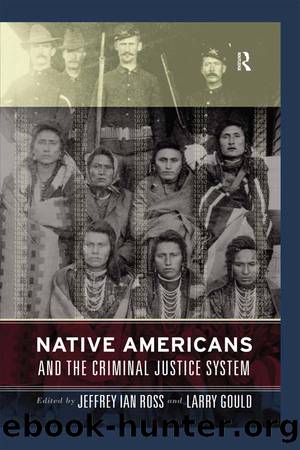Native Americans and the Criminal Justice System by Jeffrey Ian Ross Larry Gould

Author:Jeffrey Ian Ross, Larry Gould [Jeffrey Ian Ross, Larry Gould]
Language: eng
Format: epub
Tags: Social Science, Sociology, General
ISBN: 9781317255659
Google: iUBACwAAQBAJ
Publisher: Routledge
Published: 2015-12-22T02:51:33+00:00
NOTES
1 Portions of this article were originally published in Luna, The Growth and Development of Tribal Police (1998).
2 Research conducted by the authors, 1997â1999. Information obtained from this study serves as the basis for the data to be found throughout this chapter.
3 The American Indian Civil Rights Enforcement Act (S.2298); the American Indian Contract Enforcement Act (S.2299); the State Excise Sales and Transactions Enforcement Act of 1998 (S.2300); the Tribal Environmental Accountability Act (S.2301); and the American Indian Tort Liability Insurance Act (S.2302) all require the waiver of tribal sovereign immunity as necessary to enforce the acts.
4 Murder, manslaughter, kidnapping, maiming, a felony under Chapter 109 A, incest, assault with intent to commit murder, assault with a dangerous weapon, assault resulting in serious bodily injury, arson, burglary, robbery and a felony under section 661 of this title within Indian Country.
5 Alaska, California, Minnesota, Nebraska, Oregon, and Wisconsin.
6 Florida, Idaho, Iowa, Montana, and Washington. The state of Nevada asserted jurisdiction and then retroceded it.
7 Carole Goldberg-Ambrose, Planting Tail Feathers: Tribal Survival and Public Law 280 (American Indian Studies Center, 1997).
8 Ibid., pp. 86â89.
9 Ibid., pp. 45â124.
10 PL 280 states at present are the following: âmandatoryâ: Alaska, California, Minnesota (except Red Lake), Nebraska, Oregon (except Warm Springs), and Wisconsin. âOptionalâ states, which assumed full or partial jurisdiction, are Arizona, Florida, Idaho, Iowa, Montana, Nevada, North Dakota, South Dakota, Utah, and Washington.
11 This study conducted by the authors found that the number of tribal police departments had grown from 114 tribes in 1995 to 170 as of fall 1996.
12 For more on the subject of Public Law 280, see Goldberg-Ambrose, Planting Tail Feathers.
13 See the comment on a âchronic shortage of personnelâ in Indian Country law enforcement agencies, ibid., p. 6.
14 The 1980 U.S. Census figures revealed that the percentage of reservation-based American Indians over the age of sixteen who were employed was slightly higher (65 percent) than the percentage of the general population (62 percent); the income levels were significantly lower. The median family income in 1980 for reservation-based American Indians was $9,920, and 45 percent were living below the poverty threshold of $7,412. These numbers compare negatively to the general population median income of $19,920 and to the only 12 percent of the general population who were living below the poverty threshold in 1980.
15 The 1980 U.S. Census figures revealed that only 43 percent of American Indians over the age of twenty-five who resided on reservations were high school graduates, as compared with 67 percent of all Americans.
16 For more on this subject, see Stephen Cornell and Joseph P. Kalt, âReloading the Dice,â in What Can Tribes Do? (American Indian Studies Center, 1992).
17 The Federal Community Oriented Policing Services (COPS) program contends that there are five elements necessary for law enforcement to become culturally competent: (1) valuing diversity, (2) having the capacity for cultural self-assessment, (3) being conscious of dynamics inherent when cultures interact, (4) gaining cultural knowledge, and (5) adapting to diversity. These elements are provided to law enforcement agencies as part of the COPS information kit.
Download
This site does not store any files on its server. We only index and link to content provided by other sites. Please contact the content providers to delete copyright contents if any and email us, we'll remove relevant links or contents immediately.
The Borden Murders by Sarah Miller(4268)
The Secret Barrister by The Secret Barrister(3651)
Police Exams Prep 2018-2019 by Kaplan Test Prep(2512)
Coroner's Journal by Louis Cataldie(2452)
The Splendid and the Vile by Erik Larson(2402)
Terrorist Cop by Mordecai Dzikansky & ROBERT SLATER(2049)
A Colony in a Nation by Chris Hayes(1896)
My Dark Places by James Ellroy(1895)
The Art of Flight by unknow(1837)
Black Klansman by Ron Stallworth(1760)
Objection! by Nancy Grace(1759)
A Life of Crime by Harry Ognall(1706)
The New Jim Crow by Michelle Alexander(1670)
American Prison by Shane Bauer(1639)
Anatomy of Injustice by Raymond Bonner(1635)
Invisible Women by Caroline Criado Perez;(1602)
Whoever Fights Monsters by Robert K. Ressler(1588)
Obsession (The Volkov Mafia Series Book 1) by S.E Foster(1553)
A is for Arsenic: The Poisons of Agatha Christie (Bloomsbury Sigma) by Kathryn Harkup(1521)
